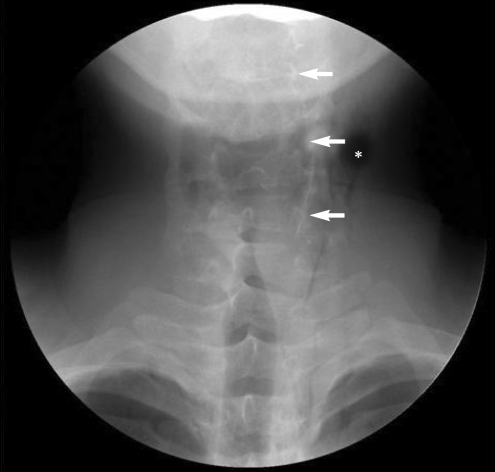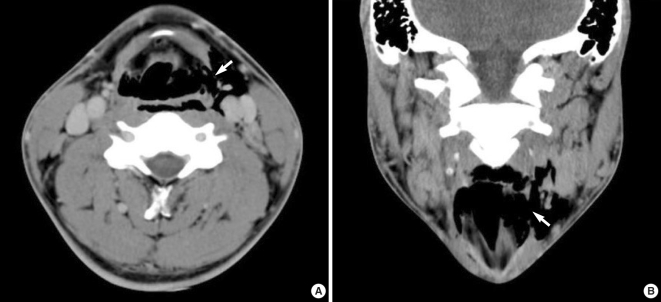Clin Exp Otorhinolaryngol.
2008 Sep;1(3):174-176. 10.3342/ceo.2008.1.3.174.
Spontaneous Pharyngeal Perforation After Forceful Vomiting: The Difference from Classic Boerhaave's Syndrome
- Affiliations
-
- 1Department of Otolaryngology, Asan Medical Center, University of Ulsan College of Medicine, Seoul, Korea. rohjl@amc.seoul.kr
- 2Department of Otolaryngology-Head and Neck Surgery, Chungnam National University College of Medicine, Daejeon, Korea.
- KMID: 1486091
- DOI: http://doi.org/10.3342/ceo.2008.1.3.174
Abstract
- Boerhaave's syndrome is spontaneous transmural perforation of the esophagus, which occurs most often after forceful vomiting or retching. This commonly occurs in the lower third of the esophagus but spontaneous perforation of the pharynx or cervical esophagus is extremely rare. This case presented a 20-yr-old healthy man with spontaneous pharyngeal perforation after forceful vomiting who had no history of instrumentation, cervical trauma, or having eaten anything sharp. Cervical pain and crepitus were the early symptom and sign of pharyngeal perforation and the rupture was detected on gastrografin swallow and CT examinations. The rupture site was higher than the upper esophageal sphincter, differing from Boerhaave's syndrome. The patient was conservatively managed without significant morbidity and mortality. Although this may resolve without surgical intervention, the pharyngeal rupture should receive early detection and clinical attention for preventing potential morbidity by late diagnosis.
MeSH Terms
Figure
Reference
-
1. Bjerke HS. Boerhaave's syndrome and barogenic injuries of the esophagus. Chest Surg Clin N Am. 1994; 11. 4(4):819–825. PMID: 7859012.2. Ohri SK, Liakakos TA, Pathi V, Townsend ER, Fountain SW. Primary repair of iatrogenic thoracic esophageal perforation and Boerhaave's syndrome. Ann Thorac Surg. 1993; 3. 55(3):603–606. PMID: 8452421.
Article3. Bradham RR, deSaussure C, Lemel AL. Spontaneous perforation of the cervical esophagus. Arch Surg. 1976; 3. 111(3):284–285. PMID: 1259564.
Article4. Agada FO, Dalati MH, Lee CA, Coatesworth AP, Grace AR. Spontaneous rupture of the cervical oesophagus following nose blowing: a case report. Int J Clin Pract Suppl. 2005; 4. (147):43–44. PMID: 15875619.
Article5. Fraser ID, Williams GT. Spontaneous rupture of the pharynx. J Laryngol Otol. 1975; 3. 89(3):317–322. PMID: 1127326.
Article6. Wake M, Stansbie M, Thompson H. Spontaneous perforation of the pharynx/esophagus. Ear Nose Throat J. 1991; 5. 70(5):318–320. PMID: 1914957.7. Gupta NM, Kaman L. Personal management of 57 consecutive patients with esophageal perforation. Am J Surg. 2004; 1. 187(1):58–63. PMID: 14706587.
Article8. Reeder LB, DeFilippi VJ, Ferguson MK. Current results of therapy for esophageal perforation. Am J Surg. 1995; 6. 169(6):615–617. PMID: 7771627.
Article9. Younes Z, Johnson DA. The spectrum of spontaneous and iatrogenic esophageal injury: perforations, Mallory-Weiss tears, and hematomas. J Clin Gastroenterol. 1999; 12. 29(4):306–317. PMID: 10599632.
- Full Text Links
- Actions
-
Cited
- CITED
-
- Close
- Share
- Similar articles
-
- Successful Management of Delayed Esophageal Rupture with T-Tube Drainage Using Video-Assisted Thoracoscopic Surgery
- Two Cases of Boerhaave's Syndrome Treated by Endoscopic Hemoclipping
- Successful Treatment Using Endoluminal Vacuum Therapy after Failure of Primary Closure in Boerhaave Syndrome
- Nonsurgical Treatment of Boerhaave's Syndrome
- Boerhaave Syndrome Presenting as Abrupt Onset of Massive Hydropneumothorax



